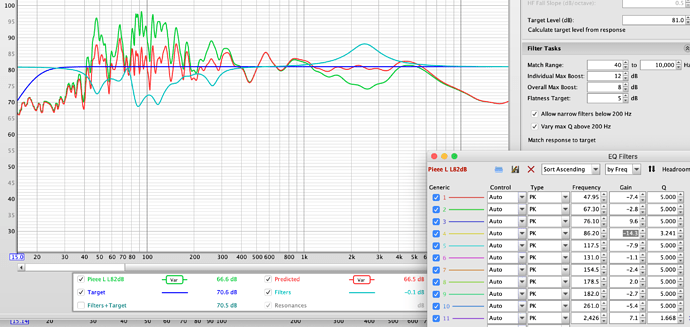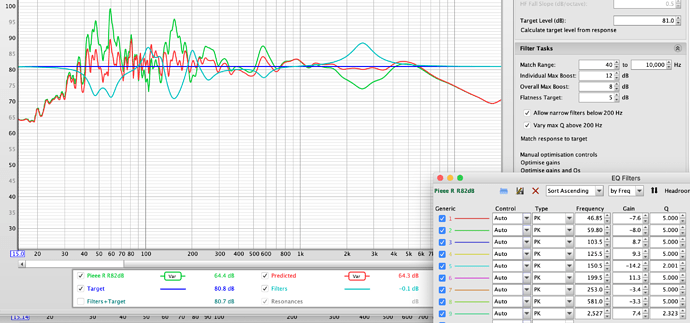I’ve consulted another audiophile and was told the RT60 data should be obtained from REW’s RT60 window. Read the max and min time on the green topt curve.
But you won’t get any RT60 data from RTA/moving mick measurement, you need to do sweep measurements for that. And even then, you can only inspect and look at reverberation and RT60 , its not possible to do time/phase modifications from REW.
Personally I like the waterfall display best, so if you do sweep measurements and want to visualize your reverberation have a look at that as well.
Finally got a few hours to properly measure and tinker with settings on my new system. The new “export all” function makes it so much easier to try small tweaks. I went through five different iterations of settings and manual tweaking, and have landed on the below.
I’ve kept things fairly “relaxed” in the low end, as I found I was losing a lot of definition with high Q’s and too many filters. So this is a fair bit of manual tweaking after auto-generating. It’s certainly not a “night and day” difference like I get on my office setup (Focal studio monitors), but definitely a bit more separation and air between instruments, and tighter bass. Also due to a hallway near the left speaker things are sounding more balanced too. Recommendations welcome. (note that I prefer doing REW flat and then tweaking house curves as Parametric EQ presets in Roon - I listen to a very wide range of music so will often change house curve when I switch from piano sonatas to psytrance)
Left…
And right…
That’s a very “relaxed” treble, but maybe you like it that way. Still, if you like you can add a filter to raise it a few dB, its not going to break the speakers unless you already push them to the max.
Maybe try to lower the peaks at lower frequencies, you can experiment and use a higher Q for that. They might end up dominating the bass and making it less distinct and more rumbling. You can also add a 3-4dB filter at 35Hz to raise that area and get more deep bass.
But judging from the very sharp ups and downs in bass response, I would look at some bass traps as well (corner superchunks etc)
I’m not using RTA, because for unknown reason my pink noise response curve is a sharp decline, 30-40 dB. I reckon sweeping is a good reflection of room acoustics.
Is it very hard to use rePhase? I hope there will be some simple and useful guide as your one for EQ.
rePhase is not made for time/phase correction either, although it does allow phase modifications. I have experimented with it, but usually I find minimum-phase filters best (which is the ones used in REW).
The conclusion I have reached is to use normal minimum-phase filters and leave time/phase alone, unless using room correction software that supports it (like Dirac).
There is a setting in REW for adjusting dB level when doing RTA, in RTA settings if I recall correctly.
Rather than reading through all 800+ posts I’m wondering if someone could point me to the posts that describe the latest iteration of how to use REW in Roon (apologies for my laziness)
Be good it there was a sticky or a KB article on this.
Except for some GUI changes in REW, the guide is still valid (and nothing has changed in Roon about how to use convolution files).
You don’t actually use REW from Roon though, you use REW to measure and generate convolution files (in this case correction files for room acoustics), and then you use those convolution files from Roon.
the conclusion I have reached is to use normal minimum-phase filters and leave time/phase alone, unless using room correction software that supports it (like Dirac)
I have experimented a lot during the past months with all options. My findings (which, if I am not mistaken, corroborate Magnus’s findings and advice):
-
generating “automated” filters from REW measurements did not work for me. In the beginning I ended up with a lot of distortion and at best I was unhappy with the sound quality
-
I had more luck with using REW measurements to create my own few equalisation filters in DSP. An additional advantage is that in this case the CPU taxing is lower and I can still use native DSD (if I use convolution my Roon Server cannot manage the #of taps and I have to convert to PCM)
-
I had a very positive experience with HAF and Thierry. The filters I got with cross talk optimization are eye-opening. But still not a panacea as I find that for some recordings they induce something akin to a partial phase inversion (an elongation of soundstage which with recordings that are anyway using out of phase techniques sound a bit weird). I alternate between “no DSP” and Thierry’s filters, and I have a few of them (with and without an extra bass correction, with and without cross talk optimization)
-
I have also taken the parallel ‘bold’ step of getting a miniDSP SH Studio which (even without room correction) can act as a pure Roon end point (via Volumio) or USB -> SPDIF converter from my EX RoonServer. I was very impressed with the Dirac filters. However, the “internals” of the miniDSP SH are not on par with my reference signal path ( ethernet to Sonore UR and then USB-> optical module of my MSB DAC). This is really a pity as the room correction capability of Dirac appears to be limited by the hardware. In that respect the option of having Dirac working within Roon would for me be the real way forward, as asked by other people as well)
Agreed! In my opinion, there are 2 steps for people who are new to digital room correction:
- Buy an USB mic and experiment with REW, for example by following this guide. This will give a nice increase in sound quality in most rooms (but you might need to experiment a little to get there). It will also enable you to figure out what tonal balance you like (which can be supplied to Therry in step 2).
- Do measures with your new mic and REW and sent to Thierry at https://www.homeaudiofidelity.com/
After 2, you pretty much reached the end-game with digital room correction in my opinion, at least for simple use with Roon.
Read Magnus’ first post at the top, then you want to thank him!
Cool advice . You opened another door for us .
These are excellent options. I would add a 3rd, which I found to be an amazing experience. While a bit more expensive, working on your room with @Mitch_Barnett at Accurate Sound is like the difference between discovering the joy of fishing with a master angler vs picking up some fish at the grocery store.
I don’t wish to take anything away from what @Magnus has contributed here…everyone interested in this topic should buy a calibrated UMIK-1 (or similar) microphone and follow this guide. When you’re ready for that next step, the choice between what Thierry and Mitch offer depends on if you want end-game results for a single room and system or you want to learn how to achieve those results for yourself. 
No worries, I wrote this guide mainly to show how its possible to get a decent result for a small amount of money. Its certainly possible to get better results than you can in REW, but it usually costs money and/or expertise help.
Having said that, I currently use convolution files from REW. I sit in a well treated and 100% symmetrical room, but still need a little frequency adjustments, and can get very close to optimal even with a cheap mic and REW. The reason for this is that most of the time, the adjustments made from the room is minimum-phase, and then you can’t (or should not) adjust in any other way than minimum-phase filters like you get from REW.
I think this is a great point that can’t be overstated. Get your room and system set up as dialed-in as you possibly can with practical means. Work with the room, not against it. Then, use a minimal amount of DRC to gently nudge the experience across the line.
Looks like Jesco is about to put out a REW guide - will definitely be worth taking a look at.
Jesco Lohan? That will be interesting, unlike me he is a real professional 
Jesco has already published some videos (for example here and here) using REW to explain some aspects of room correction. I found them well-presented, interesting and helpful.
Magnus,
I gave up reading through all of the posts. So, you may have answered that one, but anyhow:
You advertise using pink noise and RTA for the measurement. That might be the best way, however, one could do (long) frequency sweeps instead. There are many discussions going on about these two options, and as said, pink noise may be the choice for many. But in a guide like that, it might be good to mention the frequency sweep option too. At least I would not do anything else, and if it is only for the cool sound of it.

